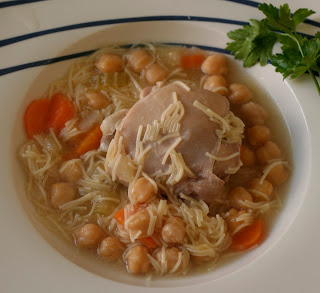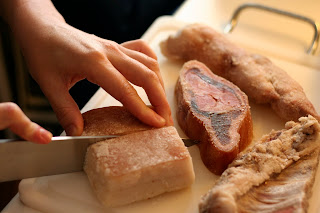
Butchers in Cadiz always have a couple of trays on top of their counter containing various strange-looking items which are used to make the caldo or stock for the puchero. These include salted lard, ribs, vertebrae and trotters, and sections of ham bone. The butcher also sells pre-soaked bags of chickpeas, in case you've forgotten to put your chickpeas in to soak the night before.

Greengrocers also provide a little selection of vegetables for use when making puchero: leek, celery, carrot, turnip and some fresh mint. Collectively, these are los avíos del puchero.

There are lots of recipes in the Sephardi Jewish repertoire for chicken with chickpeas, and it is quite possible that the Spanish versions are Jewish in origin, with the prominent use of ham bones and other pork products ensuring that cook and diners would be safe from any accusations of backsliding from the Spanish Inquisition. (Nobody expects the Spanish Inquisition ...!) This somewhat overstated use of blatantly unkosher items is a feature of Spanish food. I guess it is the culinary equivalent of a closeted gay man constantly talking about cars and girls.
Ingredients
300g dried chickpeas
1 piece of salted lard
1 piece of salted pork rib
1/2 salted pig's trotter
1 piece of ham bone
2 leeks
2 sticks of celery
2 carrots
1 small turnip
1 small bunch of mint
8 skinless chicken thighs
100g fine soup noodles
Method
- Put the chickpeas to soak in plenty of water the night before.
- The next day, place the chickpeas in a large pot, cover with plenty of water, and bring to the boil.
- Meanwhile, finely chop the leeks, celery, carrots and turnip.
- Once the chickpeas have reached the boil, skim off any scum, then add the lard, rib, pig's trotter and ham bone, bring back to the boil, reduce to a low heat and cover and simmer gently for about half an hour.
- Add the chopped vegetables, add a bit of water if the soup looks to dry, and simmer for another hour or so. Check to make sure that the chickpeas are very nearly done.
- Add the chicken fillets and simmer for another half an hour or so.
- Add the noodles and simmer until they are cooked.
- Remove the lard, rib, pig's trotter and ham bone, and serve the puchero in a soup plate.

Authenticity
I have made a couple of changes to a typical puchero gaditano, replacing whole unskinned chicken leg with separate, skinless thighs. I have also not included one of the traditional ingredients, which is a large chunk of boiling beef. In my opinion, this makes a cheap dish expensive, while the beef itsel ftends to come out a bit dry and tasteless.

There's nothing wrong with trying to produce 'authentic' versions of dishes, but I think this is something we can get too hung up on. It is often little more than an excuse for buying expensive imported ingredients instead of cheaper local ones, and can be a barrier to creativity. If you are making this soup in the UK (or anywhere where funny bits of salted pig are hard to come by), then just use a good chicken stock or substitute with something you think will work. After all, the presence of pig in this dish is itself probably the result of an earlier innovation.
Talking of authenticity, in the modern Spanish home this would almost always be made with a pressure cooker. In that case, you just bung all the ingredients in at the start (apart from the noodles) and cook until the chickpeas are done.
Cock-a-leekie
If I was more given to crazy ethnographic theories, I would suggest that Scotland's cock-a-leekie soup has its origins in a small group of Sephardic Jews who made their way north after being expelled by Ferdinand and Isabella in 1492, bringing with them their love for chicken soup. No chickpeas being available, they substituted with barley, and helped create one of Scotland's national dishes: a chicken soup containing leeks, potatoes, barley and prunes.
